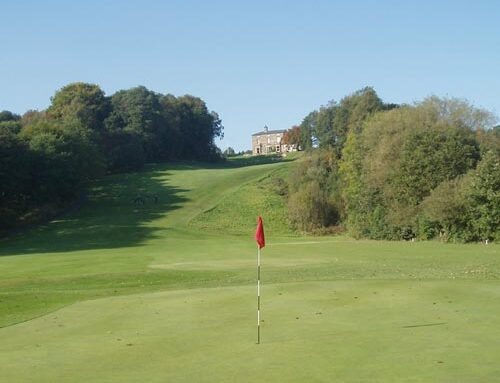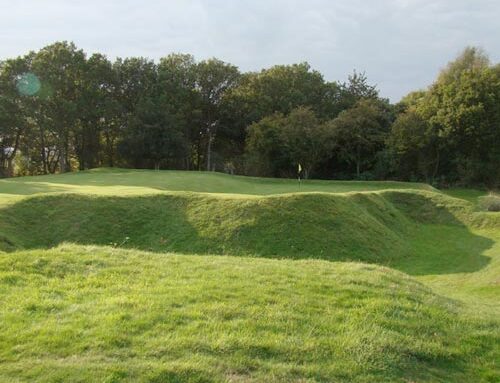Royal Cinque Ports Golf Club
Kent, England
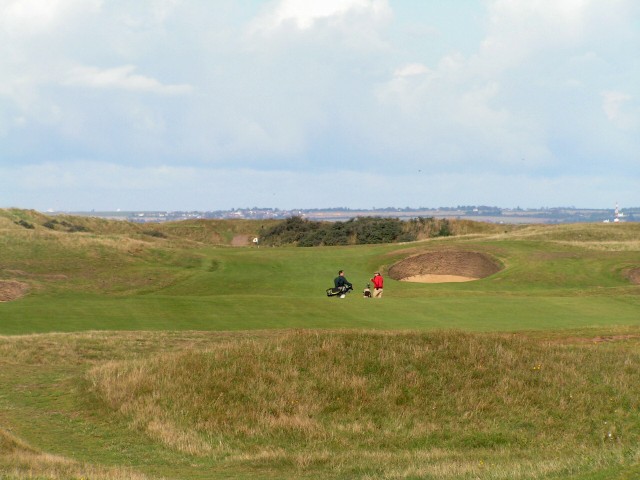
Perfection for many a golfer – rolling topography, crisp turf, a club or two wind and clear skies. Pictured above is the third at Deal.
One reason why golf is such an endlessly fascinating game is that the venue changes, unlike many other sports. Some golf courses that are even in close physical proximity still have totally different features and playing characteristics. Take Shinnecock Hills and Maidstone on Long Island in the United States. Shinnecock is set across an enormous amount of acreage and enjoys a huge sense of scale. The landscape is homogeneous. Maidstone, thirty minutes away by car, is a far more intimate routing as it is on half the property of Shinnecock. Though smaller, the property is more diverse with its most famous holes set among coastal dunes. Some golfers prefer the vastness of Shinnecock; others prefer the variety and cleverness of Maidstone.
Similarly, Royal St. George’s Golf Club in Kent along the English Channel has long been appreciated for its enormous scale. Without doubt, it is the biggest feeling course on the Open rota and is the largest scale course in England. Ten minutes to the south by car is Royal Cinque Ports Golf Club. Set on a more human scale, Deal has attracted an equal amount of glowing comments as the bigger St. George’s.

Though not dramatic, the rippling landscape at Deal possesses ideal qualities for golf. This picture is from the middle of the second fairway.
Club Historian David Dobby details how Deal evolved over its first 100 plus years and through two World Wars in his Feature Interview on this site. In short, Harry Hunter, who was the club’s first Head Professional and Green Keeper gets credit for both the club’s original 9 holes and then its expansion to 18 holes for the 1909 Open. A who’s who of golf course architects have since performed work at Deal including James Braid right after World War I. Then Major Sir Guy Campbell, Hugh Alison, John S. F. Morrison, and Major C. K. Hutchison were involved with the course in the World War II time frame. Finally, in recent years, Donald Steel has consulted on bunker and tee placement.
Of those names, Harry Hunter’s is certainly the least known and yet he deserves credit for today’s 3rd, 16th and 17th holes, which many consider to be Deal’s three most fascinating holes. In addition, though refinements have taken place, these holes were built in the 1890s, which is to say pre-Haskell ball. As Ralph Livingston notes in his Feature Interview on this site, the pre-1900 implements are radically different than the 1920s hickory clubs and balls with which golfers of today might identify. In fact, the performance of the pre-1900 clubs and balls are so significantly different, one was to wonder if Hunter would have designed the holes in the same manner had he commenced during the Haskell age. For that matter, would any great architect have had the courage to build a punchbowl green like the one that Hunter created at the 3rd? Orto build such a wild green atop a plateau as at the 16th? Like such one-of-a-kind pre-1900 holes as The Alps at Prestwick or the Road Hole at St. Andrews, golf course architecture is infinitely richer for what Hunter did. And to the credi tof all the consulting architects that since followed at Deal, none have diminished nor altered the innovative and arresting nature of these stand out holes.
For an excellent hole by hole description, please refer to Noel Freeman’s article entitled Deal Me In! found in the In My Opinion section of this web site.
Holes to Note
Third hole, 510 yards; A wonderful half par hole, highlighting the crumpled landscape upon which Deal sits. No where on this hole are the dunes more than ten feet high, yet the hole is every bit as exhilarating as any of the holes though the massive dunes at Royal St. George’s. Sadly, irrigation systems have led to the demise of many punchbowl green complexes around the United Kingdom but fortunately not at Deal. The challenge remains to get the ball into the basin in as few a shots as possible. Any shot that stays just outside leaves a very tricky recovery to the tiered green below. Approaching the 3rd green, the golfer wonders if his ball a) made it into the basin and b) how close is it to the day’s hole location. This sense of suspense surely beats the instant certainty present on many modern courses where everything is in view and ‘fair’. After all, golf is a game and games are supposed to be fun. The 3rd green complex is but one example of why golf at Deal is so much fun.
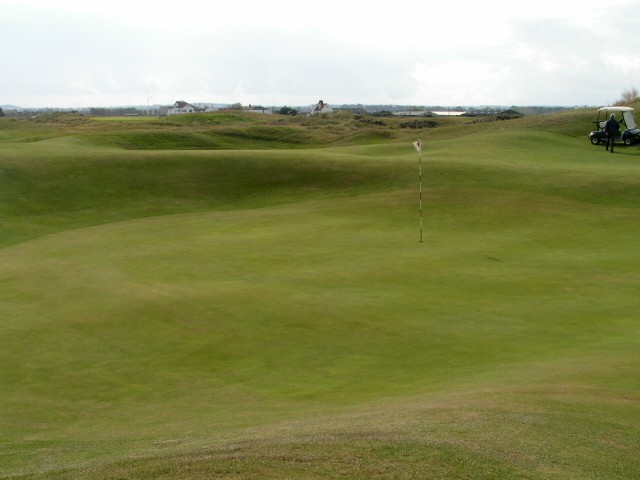
The punchbowl third green, as seen from behind, is bunkerless with the ground contours providing its highly engaging golf qualities.
Forth hole, 150yards; Though some traditionalist lament the passing of the original blind Sandy Parlour, few would argue that today’s 4thisn’t a very fine hole in its own right. In contrast with the heavily bunkered one shot 8th, this green is bunkerless. The green is domed and the effective hitting area must surely be less than3,000 square feet, no mean target in the ever present wind. A great example too of where more length would only lessen a hole: better to keep it this length and make the golfer figure out how to keep the ball down and out of the wind.
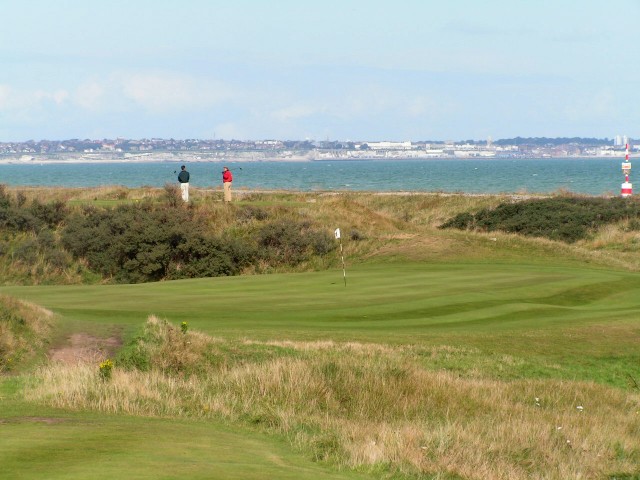
Morrison’s bunkerless green angles from front left to back right and shrugs balls off on all sides.
Sixth hole, 325 yards; Great short two shotters help make a course great. Put another way, there is no such thing as a great course that doesn’t have at least on every fine short two shotter (sorry Bethpage Black!). Technology has made this hole all the more engaging to play as assuming the prevailing south west wind behind and over one’s left shoulder, the tiger might be convinced to have a crack at the green off the tee. For the third time in the first six holes, the golfer faces a bunkerless green, which like the 3rd and 4th ones, is full of character.
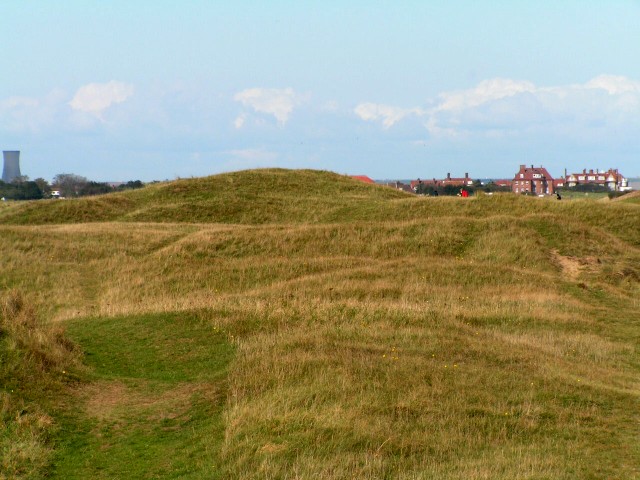
The fairway is left toward the tower and the green is right along the dune line with a player in red standing on it. A carry of 260 yards over the high point in the dune would leave the golfer a mere flick to the green.
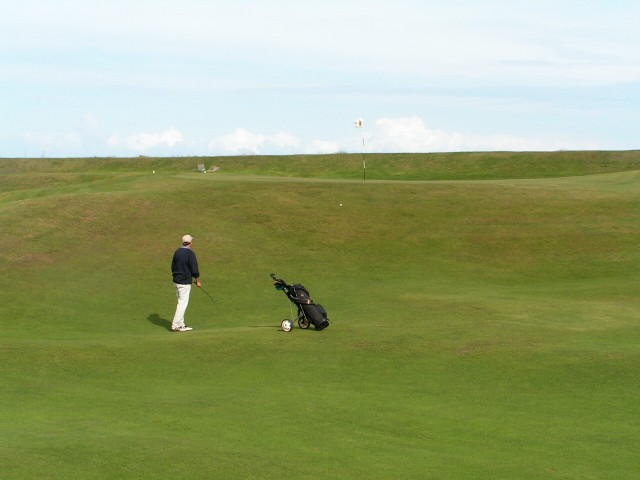
However, the sixth putting surface sits atop a plateau, the nine foot bank of which is very good at returning chip shots back to the golfer’s feet, as the man above is in the process of finding out.
Eighth hole, 165 yards; Set perpendicular to the general north-south direction of the holes nearer the clubhouse, this is the first time the golfer sees the wind from this direction. The golfer might therefore hope for a bit of room but, alas, with nine bunkers, this green complex is the most heavily bunkered on the course.
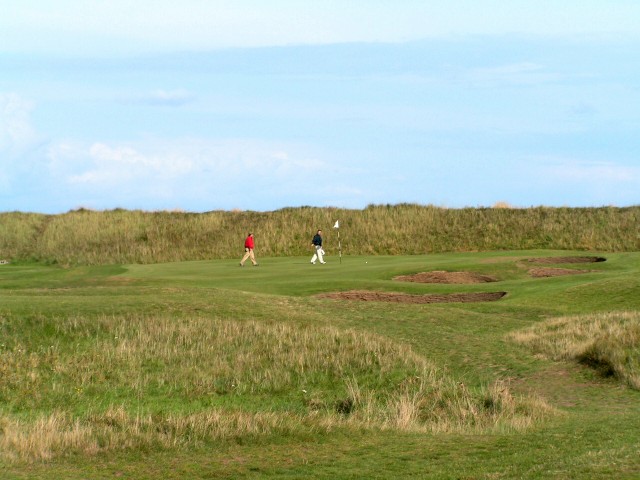
The seawall is the backdrop to the eighth green.
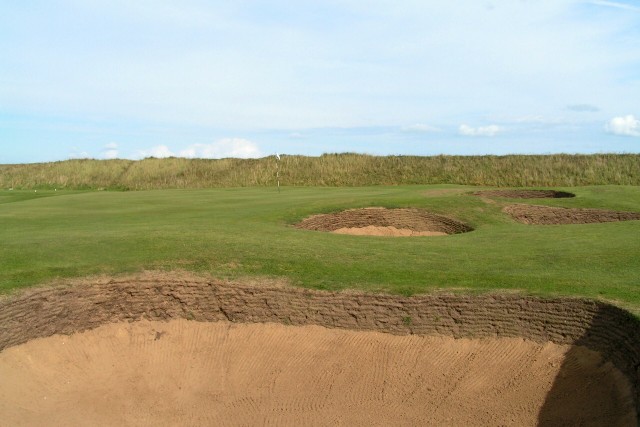
Tightly guarded, the golfer often times has to contend with a right to left crosswind. The player with the skill to hold a fade against the wind relishes the opportunity to showcase his skills.
Tenth hole, 365 yards; According to David Dobby, James Braid added the 8th through the 12th holes in preparation for the 1920 Open. These holes occupy the flatter portion of the property with less natural features with which to work. To Braid’s credit, he created holes of lasting interest, with this one being particularly clever. The green is set at an oblique angle to the tee with a seven foot deep depression being used to maximum effect as shown below.
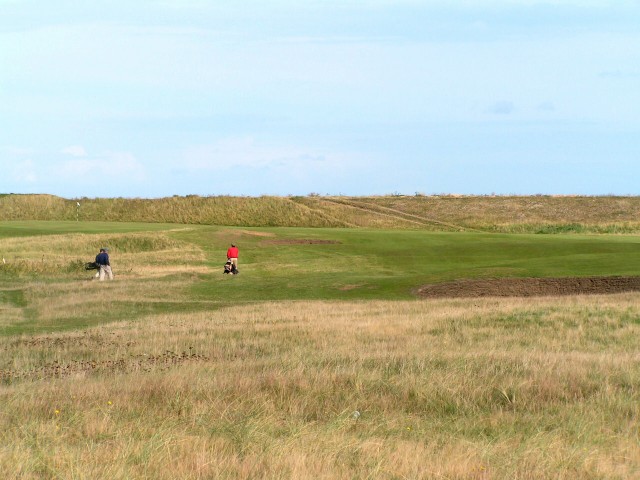
The view from near the tenth tee: the lure of the flag left (over the golfer in navy) pulls the golfer that way but the ideal angle of approach to this angled green is from long down the right side.
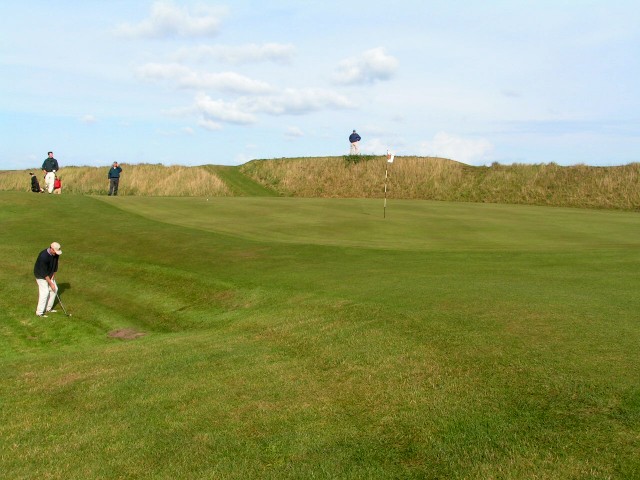
This approach to the tenth at one time was within ten feet of the day’s hole location, before rolling down into the depression.
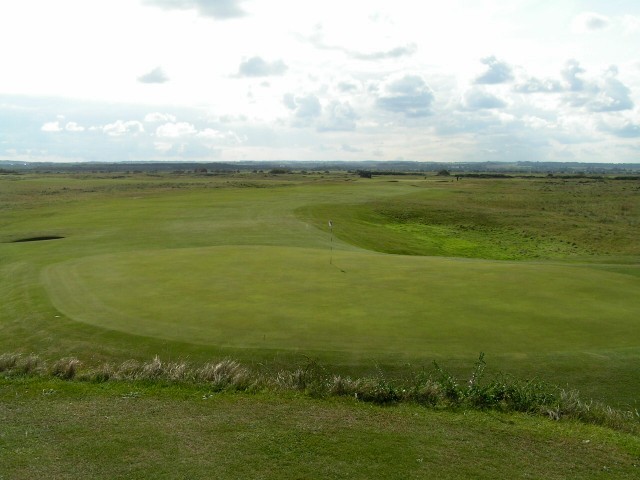
The view back down the tenth as seen from standing on the seawall shows the ideal angle into the green is from the right side of the fairway.
Twelfth hole, 450 yards; Deal’s famous finish begins here, with the hole being made by Braid’s unique ‘u’ shaped green complex. Though the flattest hole on the course, how could any golfer ever tire of hitting to such an attractive green sunk as it is between two ridges?
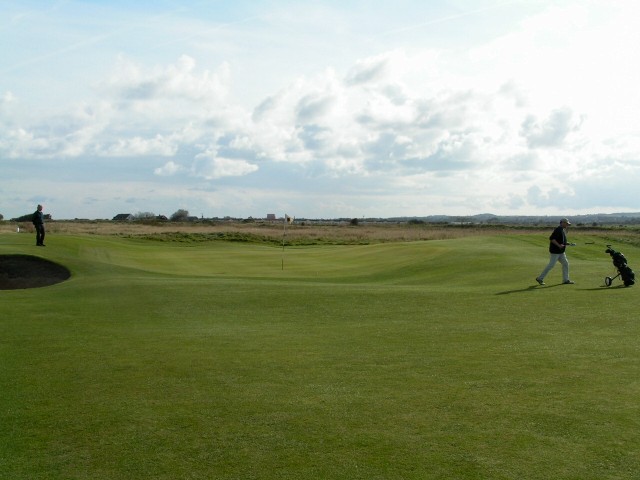
Deal’s green complexes are both varied and many are one-of-a-kind. Take the twelfth for instance: no reason to get in the bunker left as the green’s right slopes work the ball nicely onto the long putting surface.
Thirteenth hole, 420 yards; Variety of challenge is a- some say the – most appealing attribute for any design to possess. When analyzing a course for that potential quality, some look at the holes in their totality while others like to break up the one, two and three shotters and look at the pars separately. Whichever way is fine and in the case of the two shotters at Deal,the 1st and the 18thare bunkerless while 7th and here possess the most bunkers on the course with eight. Of all the bunkering patterns at Deal, the 13th is as appealing as any. Two large bunkers on the inside of the dogleg require a carry of 215 yards while three cross bunkers bisect the fairway 105 yards from the green. Which set of bunkers is more problematic shifts with whether the hole is into or downwind.
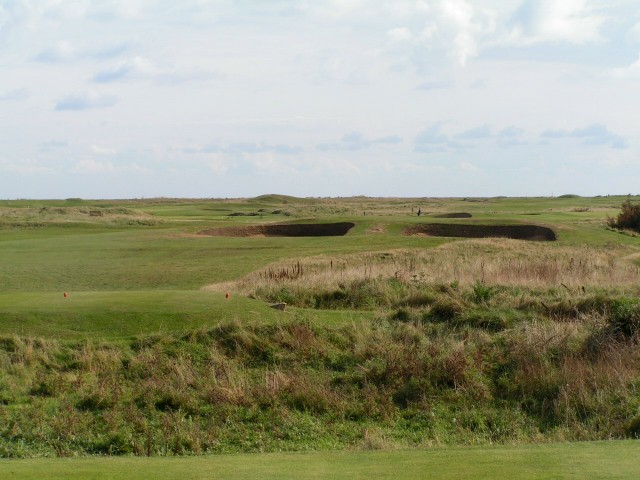
This dominate pair of bunkers off the thirteenth tee need to be carried to have the best angle into the green, which is bunkered only on its left side.

The thirteenth putting surface is the high point of its surrounds, making it hard to hold as well as readily identifying the better ball striker – an excellent low profile green complex.
Fourteenth hole, 220 yards; Deal has hosted two Opens though floods and two World Wars prevented it from hosting three other ones. As one might imagine from a course that is highly sought to identify the best players, the ability to hit controlled long iron shots is a requirement. In an effort to keep the challenge of the course current with modern technology, the 14th has been lengthened by 25 yards since Deal was to host the (canceled) 1938 Open. Now as then, the player must punch a low boring long iron to a none too big target.

As seen from a distance, the fourteenth looks like a fairly straightforward one shotter…
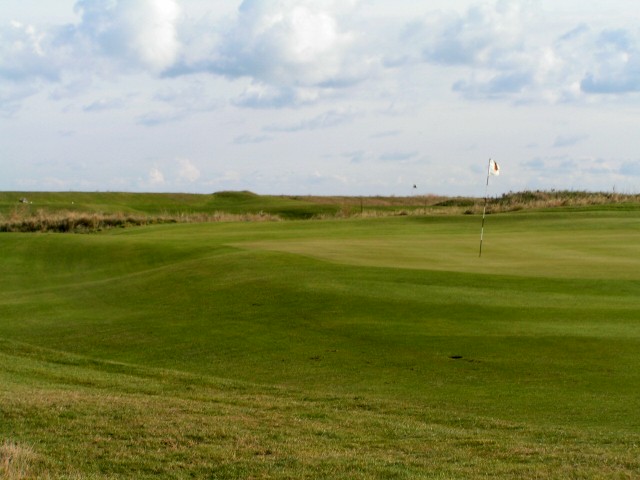
…but closer inspection shows a severe green complex. This front hole location presents a most difficult up and down for any shot missed left. Better to use the green’s right to left tilt to work the ball toward the left hole locations.
Fifteenth hole, 450 yards; Standing on the 15th tee, the golfer is in the heart of the original 1892 nine hole courseso he is not surprised to find ideal golfing terrain with random land movements of one to six feet from tee to green.
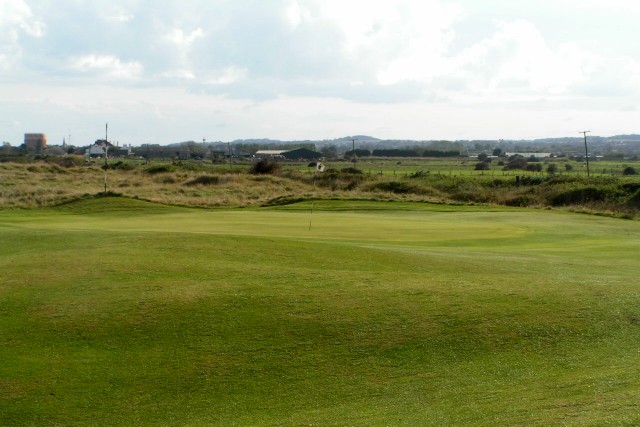
Lay of the land architecture at its very best: the hump on the left serves as a runway for shots onto the fifteenth green, which slopes from front left to back right. Trying to judge such an approach remains endlessly fascinating, something that cannot be said of many of the forced carries found on modern courses.
Sixteenth hole, 505 yards; Sir Peter Allen calls this ‘a hole in a million’ and surely either this hole or the 3rd would be included in any eclectic 18 hole compilation of the United Kingdom’s finest holes. Mark Rowlinson in The Globetrotter Golf Guide to England and Wales succinctly describes the challenge of the hole when he writesthat ‘from any distance the green is hard to hit and hold, perched as it is on a minor mountain.’

A power fade hammered at the fairway bunker above is ideal and leaves the golfer…

…with this view, one of the greats in the game. The elevated green is within reach from here. By looking/admiring the natural folds and humps and bumps, the golfer concludes that mother nature offers the most compelling terrain.

Club Historian David Dobby stands on the plateau green while the golfer on the right rues his decision to try and reach the sixteenth in two.

Now lying three, the golfer ultimately cards a sad seven but at least is in good company: dealing with the terrain 60 yards short and in of the 16th green complex has vexed golfers for over 100 years. No wonder Bernard Darwin termed it the ‘valley of inglorious security’!
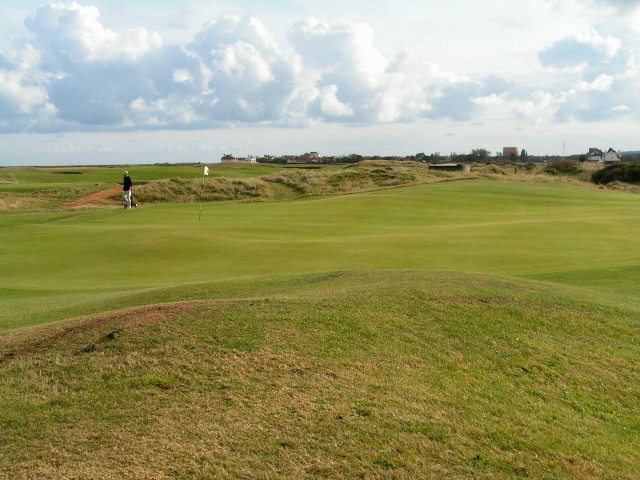
This wildly undulating putting surface caps off the sixteenth hole.
Seventeenth hole, 390 yards; Deal’s strong hold on Bernard Darwin is legendary and in part must be due to the fact that the sand dunes, ridges, and humps and hollows run throughout the course and especially in the fairways.Deal is at the other end of the spectrum from Royal Birkdale where the dunes mainly serve to frame the holes and the golf is generally played from flat fairways and level stances. At Deal, the golfer is always adjusting his stance and the 17th fairway is as roly-poly as any on the course. Vardon’s Palour is a basin down the the right of the fairway from where the flag can be seen; any drive left of center is likely to yield a blind approach. And just as the fairway is full of character, so too is the green complex where the natural folds in the ground around the green feed well into the putting surface. This wonderful penultimate hole leaves the golfer wishing that more holes of this length were played at this point in the round.

The massive cross bunkers cut into the hillside are 300 yards from the seventeenth tee.
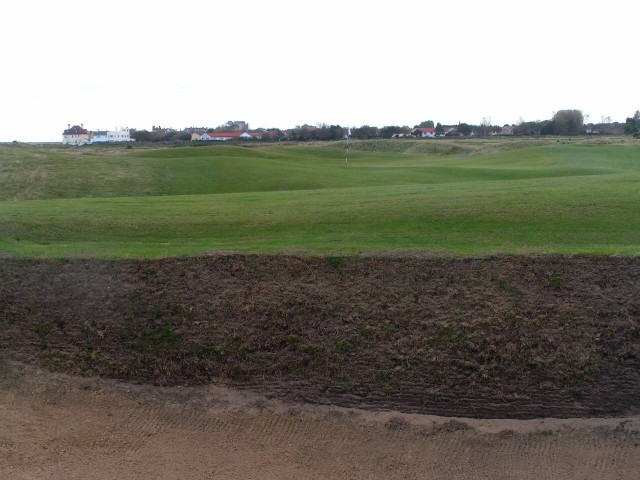
Just look at all the interest that the ground holds 60 yards and in at the seventeenth.
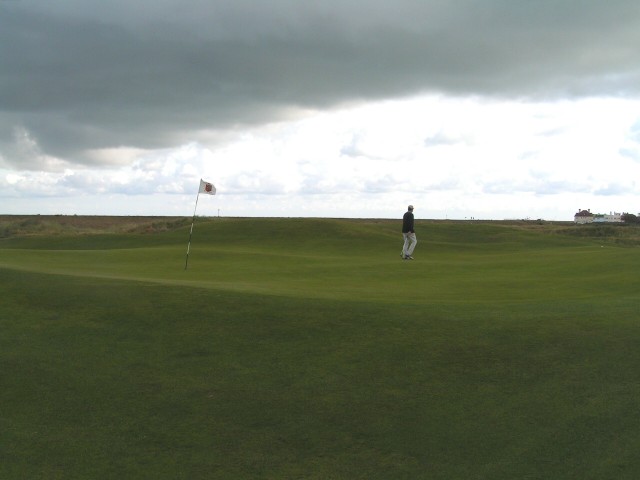
As with the third and sixteenth greens laid out by Hunter, the seventeenth green contains many wonderful natural rolls.
Eighteenth hole, 410 yards; Not as dramatic as the holes that immediately precede it, this becomes a very fine Home hole because of its raised kidney shaped green complex. Some approaches will catch the right edge of the green only to roll off the plateau and leave an interesting chip or putt back up the three foot slope. Other approaches may catch the bank and be kicked further from the green, leaving a very awkward recovery shot across flat ground to the raised green.
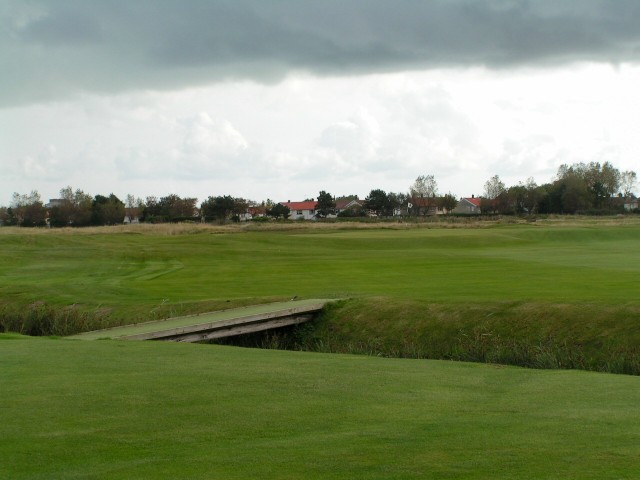
The ideal tee ball from the closing tee leaves this approach shot from just short of the burn.
One thing’s for sure: As at The Old Course at St. Andrews, to add to the pressure at the 18th green, prying eyes from the clubhouse window will be taking in all the action.
And speaking of the Old Course at St. Andrews, its influence on the evolution of Deal is evident. Like St. Andrews, the routing of Deal is of the out and back variety with a loop at the end, a burn guards the 1st green (which makes for an excellent 19th hole as well), the ground is not dramatic but it is full of wrinkles and creases into which bunkers were cut, and the green complexes are well and truly varied allowing the course to play equally well whether the wind is with or against on the way in. Deal has a famously strong finish like St. Andrews. Also, too, the author’s favorite single shot at Deal (the approach to the 15th) shares the attribute that St. Andrews possesses beyond all courses: a controlled shot to a green that runs away from the player. In the case of the 15th at Deal, the play is to miss the green long as the resulting return chip is none too difficult but like The Old Course at St. Andrews, getting to know the smart misses takes years and years.
Also, as at St. Andrews, the terrain flattens out for a few holes around the turn. However, like St. Andrews, the golf quality never suffers. Indeed, those who cite St. Andrews as their favorite course in the world are quick to point to the great merits of the dominate bunker at The Short hole at The Old Course or how the 10th green may be the course’s most perplexing. Similarly, one’s ultimate opinion of Deal likely depends largely on one’s thoughts regarding the merits of its first twelve holes, not its famous finishing stretch. The clever angles at Deal’s 10th and Braid’s excellent green complex at the 12th are but two examples of the course never losing its appeal and of maintaining a high standard throughout all eighteen holes.
With the round concluded, the golfer repairs to the bar on the second floor of one of the United Kingdom’s most attractive clubhouses, offering views across the English Channel to France. Thinking back over the day, who can fail to be impressed by how solid the eighteen holes are? Every hole is of appeal, from the rippling 1st green across the burn, to the crumpled 2nd fairway all the way along to the plateau 18th green. None of this is by accident and to peruse David Dobby’s Feature Interview on this site is to understand that much care and thought has gone into the evolution of these links. The enthusiasm with which Noel Freeman writes about Deal in Deal Me In! was echoed in every decade of the 20th century by various esteemed writers/players/critics.
More is the pity is that golfers rush to play courses on the modern Open rota, not understanding that the historic links at Deal still offer a superior form of links golf to this day. In sum, to quote Mark Rowlinson again regarding Deal, ‘True, there are blind shots, short par 4s, and uneven fairways, the sort of thing deplored by some modern players, but they are appreciated and expected by connoisseurs of true links golf.’
The End



![Minchinhampton (Old) [2016]](https://golfclubatlas.com/wp-content/uploads/2018/09/Minchinhampton-500x383.jpg)
![St. Enodoc (Church) [2017]](https://golfclubatlas.com/wp-content/uploads/2017/11/St.-Enodoc-500x383.jpg)
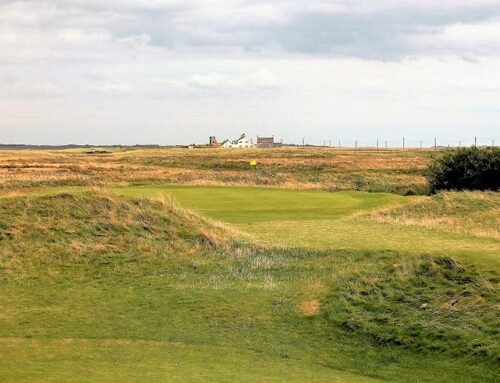
![Sunningdale (Old) [2014]](https://golfclubatlas.com/wp-content/uploads/2017/11/Sunningdale-Old-Course-500x383.jpg)
